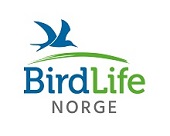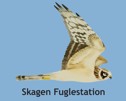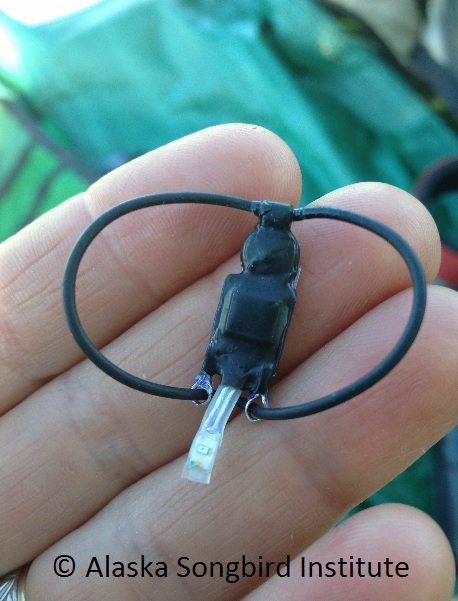
|
|
Whinchat, watercolour by Øivind Egeland. Not all geolocators might have a negative effect on survival On February 1st a new study was published on Journal of Avian Biology. The title of the article is An experimental evaluation of the effects of geolocator design and attachment method on between-year survival on Whinchats Saxicola rubetra. This article shows that not all geolocators might have a negative effect on survival, but that different materials and techniques might affect significantly the biology of them. By Aïda López The article presents the results from a study carried out by researchers from several institutions from the UK, Nigeria, Liberia and Australia. The study was carried in Nigeria, in the guinea savannah where the density of Whinchats in winter is high, with the purpose of evaluating how geolocators impact on the survival rate. How do geolocators work? Geolocators are electronic devices normally placed on small birds for tracking individual migratory routes. They are unique thanks to their small size, light weight and low price. Geolocators are composed of a battery and a light sensor which generates and stores light data at regular intervals, getting the light intensity and the angle of the sun. Getting the light intensity (hours of daylight) on a given day of the year, it is possible to get the latitude. The same way, if we know the angle of the sun, we can get the noon time for a given day and then it is possible to get the longitude. These two variables are stored on the geolocator, getting an approximate position for every data set. From these records we can get very valuable information, such as individual migration routes, stopover places and times, wintering areas, individual arrival, breeding and departure times, etc. On the other hand, a difficulty is that geolocators need to be collected for data downloading and analysing, which means that birds need to be recaptured. In addition, there is lack of tools and standards for data analyses. The effects of geolocators on migratory behaviour, breeding success and survival rates are poorly known. There have been some studies involving geolocators on small birds which suggested that geolocators might reduce survival rate. However, new studies are carried every year and more knowledge is acquired.
What did this study involve? A total of 472 Whinchats were trapped and handled. 156 Whinchats got a geolocator on and 316 did not. The birds used in this study weighed more than 15 g and the mean mass of the geolocator was a 4,13% of the bird’s body mass. The researchers experienced with different geolocator materials (elastic and non-elastic nylon harnesses), different stalk lengths (0, 5 and 10 mm), different tag masses (from 2,5 to 5,3% of body mass) and different level of attachment (loose and tight). The goal was to evaluate different materials and attachment methods and estimate the possible effects on the birds. What were the main results? What it was found is that neither wearing a geolocator with elastic harness nor the length of the stalk nor the tag mass had significant differences in whinchat’s annual return rates. However, the material of the harness showed relevant differences. The birds which had a tight and non-elastic harness had a significant lower resight rate (average of 53% reduced re-sighting rate) than those which had the geolocator attached with an elastic harness. The level of attachment appeared to be less important on elastic harnesses than on the non-elastic ones, probably because of the flexibility of the material. One probable explanation for this is that Whinchats, before starting the long migration trip, increase muscle mass and fat deposits, increasing more than 50% of body mass. That might be a problem when wearing a tied, non-elastic harness which might not fit correctly the new size of the bird, constricting the body. Most experts suggest that attached devices should be around 3-5% of the body mass. A satellite GPS weighs around 27 g, a GPS datalogger is around 2,5 g and a geolocator around 0,5 g. This means that only geolocators can be used nowadays for tracking individual movements of small birds (>= 15 g), which are the majority of bird species. This article shows that not all geolocators might have a negative effect on survival, but that different materials and techniques might affect significantly the biology of small migratory birds. | ||||||

| Ringing numbers |
|
Sorry, but we are outside of the spring and autum seasons. Detailed log |
| Reportasje fra Lista FS i Aftenposten |

|
| Seasonal deviation | ||||||||||||||||||||||||||||||
|
|
Følg Følg Lista FS på facebook.com |
| Siste 5 på siden |
|
Lista Fuglefestival 2025 Looking for bird ringers for spring and/or autumn 2025 Begynnerkurs i ringmerking: 26.-27. april 2025 Report from autumn 2024 Lista Fuglefestival 2024 |
| Nyheter fra NOF |
|
Har du funnet en måkeunge?... Tvillingartene: Hauk over hauk Hvor mange fuglearter finnes... Statsforvalteren opphever... Storskarv i Europa i... Norge må heve stemmen for... Ny nødvergeparagraf i strid... Solid mangfold på Fuglenes... |
Lista Fuglestasjon
Fyrveien 6
NO-4563 Borhaug
post@listafuglestasjon.no Tlf: 949 86 793
 |  |


 Only in English
Only in English




